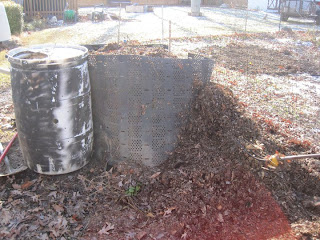It's no secret that Deb and I love greenhouses. It's finally time we have our own. I've had cold frames before, standing one to three feet above the soil. There's just something cozy about being in a warm humid greenhouse surrounded by green lush plants when it's cold, dry, and windy outside. We spent hours looking at videos online of various methods of building greenhouses. We decided on one and jumped into the project. We should be done within one to two weeks. The frame is done now.
The worms are here! 500 redworms arrived in the mail and I got right to work. The worm farm had to be prepped with some starter compost for beneficial organisms, shredded newspaper, and the supplied cocoa peat material. The worms need appropriate bedding and moisture retaining materials to sustain the right humidity they need. For now, I can only add a small hand full of kitchen scraps per week. As the worms reproduce and increase in numbers, the food intake and compost output will speed up. Each of the three trays can house up to 3,000 worms, so the 500 may turn to 9,000 in 3 months! Food consumption can reach about 5 pounds of kitchen scraps per week. The best part is, no smell.
Deb and I spread out some finished homemade compost on the big garden. Last year the garden was not organic under the care of my late grandfather. This year, it's going organic. The use of chemical fertilizers last year means there were no slow release nutrients causing diminished soil microorganism activity. This has probably rendered the soil in major need of some real fertility. The compost will help, but my secret weapon(no longer a secret?) is kelp meal. Kelp has no substantial amount of the big 3 (Potassium, Phosphorus, Nitrogen), but it is amazingly rich in tons of other nutrients that are often in short supply. I've used kelp meal in the past and had great results. I'll be putting the kelp out mid February.
Next, we turned over & moved the massive mound of unfinished composting materials at the big garden. Although the air temperature was around 35 degrees, the inside of the pile was steaming hot. We must have a good ratio of carbon/nitrogen and good moisture. We've probably got about 100 gallons of organic matter breaking down right now. If we weren't adding anything else, after the decomposition completes this would make somewhere around 10 gallons of compost.
In the past I've always had my seeds in various bags and envelopes. This worked for the first time sowing seeds, but when going back to them again, I found major clutter and often spilled seeds. This year I wanted a new method for keeping our seeds straight. We bought some bead organizers from the craft store. It took about an hour to organize them all, but they are all neatly tucked away in their little containers now, clearly labelled.
Two weeks till seed starting time!










No comments:
Post a Comment